
The Kitchen was originally the dining room as labelled on the plan above. In the kitchen the Aga was on the left of the door as you entered from the hall. Drop scones were made by pouring the mixture directly onto the hot plate. On the left of the Aga was a long line of cupboards which sometimes had rescued hedgehogs in the bottom , and trays of cakes on top. On the right stood a kitchen table which had a drawer that you could open at either side and behind it was a butler sink. (Where chickens were gutted and rabbits skinned.) In the far corner between the windows was the circular table where breakfast was eaten and a ‘wee bit of parritch’ with milk on it for the cats and dogs to lick was left at the end. The portrait of George Annett Grey hung over the table. The original curtains had been navy blue and white with bobbles round the edge which kept falling off. At the back the kitchen door led to the pantry,( labelled kitchen on the plan above) which had a butler sink and another door led out to the yard with its water troughs. Above the yard hung a bell on an arch which was rung in the 1930s to tell the Grey children to return form the tennis court and wash their hands before meals.
Below: The kitchen table below with the portrait of George above it.


The Smoking Room , marked on the plan as Library.
Returning to the inner hall the door on the left led to the smoking room. It originally had a large writing table in the window and the room was lined at both ends with leather bound books on local and natural history amongst other subjects. A pair of horns hung over the fireplace and there were more foxes and otters heads. A dining room table with leaves that you could add to make it bigger filled the centre of the room, and was added when the original dining room facing the back drive became the kitchen. A huge wooden ruler recorded children’s heights and a large atlas had to stood on because the measurement didn’t start at floor level. Rose bushes grew outside the windows.
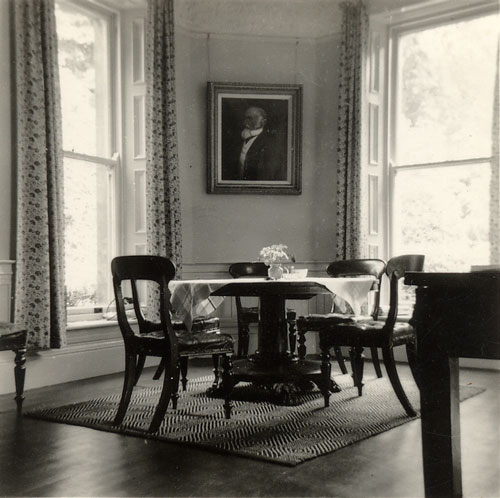
Entrance hall.
Three steps led up to the entrance hall which was lined with stuffed animals in cases. These included a Bewick swan and a white pheasant, there were labelled horses teeth showing different ages, and the stuffed heads of foxes and otters. At ground level a cupboard on the left held bowls, huge big dark polished wooden balls and curling stones. Going through the swing door, wedged open with an old curling stone, led to the inner hall. The kitchen door was on the right and to the left of it a fireplace and then the stairs, which faced the old front door. Two solid oak bookshelves stood here made from trees from the estate. Family portraits hung on the walls. Below: Through the kitchen door Mary Burn's portrait can be seen in the hall.
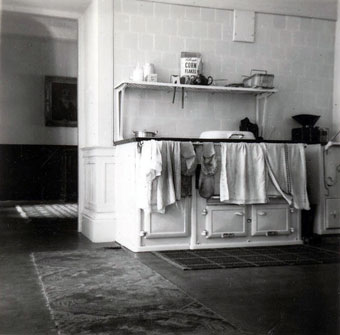
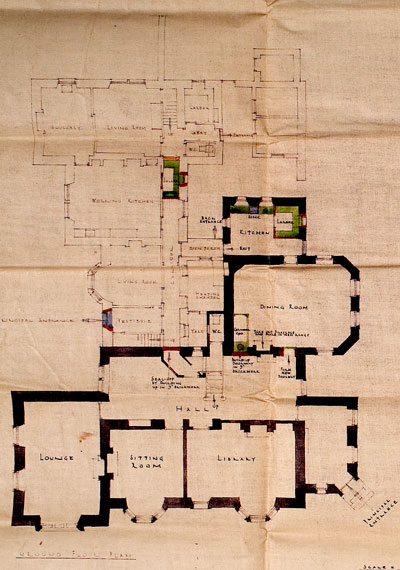
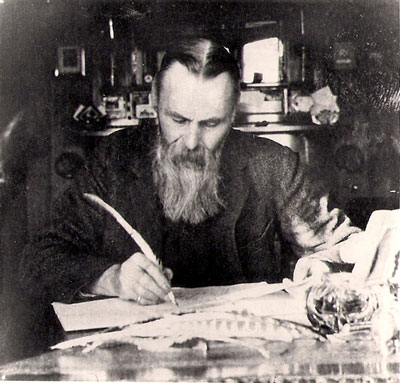
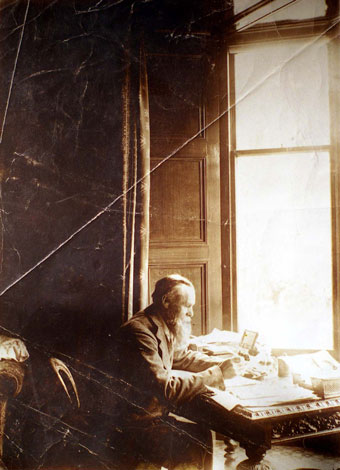

The Morning Room Marked on the plan as Sitting Room.
Next to the smoking room was the the morning room. (Pictured left.) On each side of the fireplace the bell pull handles were shaped like Qs , a circle with an s shaped handle on the right to pull down. All the bells that connected to the pulls were in the back passage a part of the house made into separate living accommodation in the 1950s. In the morning room Kathleen Grey had a desk. A magic cow with movable legs lived inside, which when you put it on a slope walked down by itself. A wind up gramophone with 78 records was used well into the 1960s. "Big Rock Candy Mountain" being a favourite. A portrait of Selina Blake hung on the wall and a portrait of an unknown woman known as Emma after the name on the vase she was holding.
The Drawing Room/Playroom/Ping Pong Room. Marked Lounge on the plan.
The door at the end of the hall led to the drawing room,later called the playroom which was very light with tall windows and mirrors and could have been used for dancing. The wall paper was green and gold and it must have been a very beautiful room at one time. It had a good wooden floor and a ping pong table. It was unfurnished from the 1930s to the 60s. In a corner was a built in seat which sagged in the middle which Angela Grey recalled was the favourite place to sit after you lost at ping pong.
The Hall.
On a mantelpiece in the hall in a carved wooden cup was a cannon ball from the battle of Flodden. (The whole house was full of things that had been dug up over the years including coins, and an ancient burial urn dug up on Whitten Hill which was sent to the Hancock Museum in Newcastle in 1965.) In a case was a shell with a label ‘Fired at Ladysmith’. In the space on the left of the stairs there was a large fir tree at Christmas time with real candles held in candle holders attached to the tree with metal clips. Through a big dark polished swing door at the foot of the stairs there was a basin straight ahead of you while on the right , down two steps was the door to the cellar. Left up two steps was the downstairs loo. To the left of the basin going up three steps led to the back passage, on the left the bottom of the back stairs, next on the left a storage room and then a small sitting room. Further on on the right the old boiler room for the central heating which was never used. A bit further on the right a small passage led to the butler's pantry and the back door on the left. This part of the house was blocked up in the 1950s so you couldn't go beyond theW.C. and opening the door only led to a blank wall. Guns were kept in a cupboard near here.

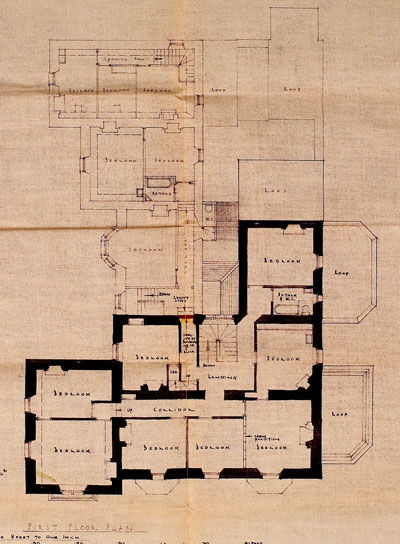
Upstairs
The main front stairs had curving polished banisters and metal cast iron uprights. One of Jack Grey's friends fell downstairs and smashed one off. These stairs were sold when the house was demolished and may still exist somewhere. There was a landing where the stairs turned with a window which had a metal horse and foal on the window sill. At the top of the stairs an arch opened onto a corridor which led to the bedrooms at the front of the house. In a recess was a trunk which held silver that wasn't being used and important documents. Facing the top of the stairs the front bedroom above the smoking room was used by Kathleen and Ivar Grey before WW2 and a door led to Ivar's dressing room which had one wall made into a huge cupboard with large sliding doors. Jack Grey used it later on, although only in the summer; he moved to the one above the kitchen for warmth in the winter. Along the corridor to the right was the blue room, a small single room which Angela Grey used when the house was divided up. This room was where Josephine Butler was born. Two steps led up to the big west bedroom which Kathleen Grey used in in the 1950s. (She kept a little lacquer box in there full of oddities which included a bracelet made of elephant's hair.) Returning to the top of the stairs the landing on the left led to another bedroom which had a single iron bedstead, and was quite dark, due to the trees outside. Next to it the bathroom which had a tiny triangular sink outside of it hidden behind two wooden doors. The bathroom overlooked a flat roof where Kathleen put out bread for the birds. A bedroom was beyond this which was used by Lina Grey. In the 50s it contained a strange and wobbly wardrobe which was circular and whose door slid into itself to open. Before the house was divided up in the 1950s if you turned right at the top of the stairs before going through the arch there was a swing door which led through to the other wing. Immediately behind the door was another bedroom and beyond that two steps which led to where the back stairs came up. A narrow flight led to the tower room and the box room where the water tank was. It was often full of bats. This part of of the house, with its 3 bay windows was later lived in by Anne Mildred. Returning to the landing just inside the swing door on the left a spiral staircase curved up to the attics. The attics were made for the maids and it was rumoured that the parapet in front of the windows, a later addition to the house, was built to stop the maids seeing out and being able to wave at the boys in the village. These rooms had sloping ceilings and were full of fascinating junk in the 1950s; more stuffed animals and lots of old swords. These were later sold to a specialist in Alnwick. From here you could reach the roof and the flagpole.
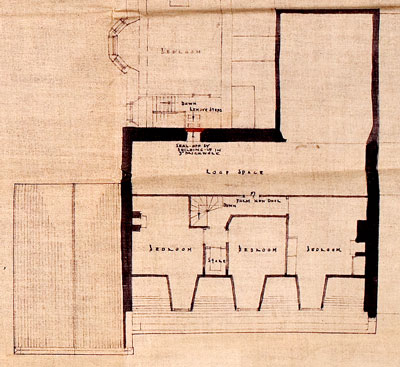
"Whatever happens you must certainly come to Milfield because I feel sure you will approve of it. It is such a lovely place and you can do exactly as you please. It is an excellent place at which to do absolutely nothing and the lawn is the approved place for lying on a rug in the sun. Or, if you are feeling energetic you can walk up to the Badger wood or down to the river. I could ramble on happily in this strain for hours but you must experience it yourself before you will believe all that I tell you about Milfield, and I hope it won’t be very long before you do. One last thing-do you like having dinner by candle light on a polished mahogany table? I do and it is the only illumination apart from lamps that we have in our out of the way spot. It would be nice to see a candle in a tall silver candlestick again and not in an empty beer bottle like mine." Robert Grey writing to his future wife Anne during WW2 on 14.4.1944
"Owls always fascinate me and I used to enjoy having them near the house at home. I have my own special family of owls who live in a barrel in a sycamore tree near my window. Mummy sends me reports about them each year and I gather they produced the usual raucous family this spring. I suppose my liking for them dates back to very early days when my father used to produce baby owls from a hollow tree in the drive and we would stand and gaze open-mouthed and wide-eyed." Robert Grey 2.6.44
"I wish I could take you to Milfield now. ... I am afraid from my description you probably imagine something rather wonderful when there is really only a rather shabby house with hardly any mod.cons., full of decrepit furniture; stuffed animals and stuffier ancestors glaring from every wall; surrounded by gardens grown wild like the Secret Garden. If this does not scare you, then you will probably love it like almost everyone who has ever stayed there. If you like candle-light and log fires, old trees and old books and laughter and crazy people, then come soon." Robert Grey. 1.11.1944
